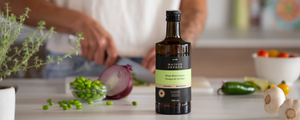BY SCIENCE + FOURCHETTE
Making a homemade vinaigrette is an art-and a simple one at that! Knowing the basics is all you need to add flavour to a variety of recipes. Here's everything you need to know to become a homemade vinaigrette pro!
OILS AS A FOUNDATION
The basis for a perfect vinaigrette is oil. It's best to use a quality fat that has a pronounced taste. We won't lie when we say it's the secret of a tasty vinaigrette. Our favourite is undoubtedly Maison Orphée organic unrefined sunflower oilwhich takes an ordinary vinaigrette recipe to an extraordinary level. Extra virgin olive oil, Grapeseed Oil, walnut oil Gold sesame oil are all oils that will enrich your vinaigrettes.
To add even more flavour to your vinaigrette, don't hesitate to use flavoured oils, which can be combined with another oil.
VINEGARS ADD A FLAVORFUL PUNCH
A vinaigrette will never be a true vinaigrette if it doesn't have its fair share of acidic ingredients. With a few dashes of vinegar, such as Balsamic, cider, red Gold white wineare excellent choices. Since vinegars come in a wide variety of flavours and intensities, don't forget to taste them! Our favourite is probably organic white balsamic vinegar for its fruity taste.
KEEP THE RIGHT RATIOS IN CHECK
Although there are no rigid and exact proportions, we recommend starting with a ratio of 3 parts oil to 1 part vinegar. After that, you can adjust the ingredients to suit your own tastes and preferences.
DON'T FORGET THE SUGAR AND SALT
Before adding spices and other herbs, think of salt. Every chef's go-to flavour enhancer, it will balance out your vinaigrette. You can also add a small amount of sugar, which can soften the acidity if you've added too much salt.
CREATING EMULSION
An emulsion is the result of combining two liquids that don't mix spontaneously, like oil and vinegar. To succeed, you need an emulsifying agent, like mustard. To create it, slowly drizzle the oil over your ingredients while whisking. Your vinaigrette is ready as soon as you get a smooth, creamy texture!

